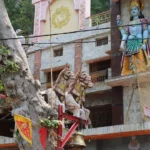The Mythological Roots
Naimisharanya often enveloped in an aura of mystique and reverence, holds a prestigious place in the tapestry of Indian mythology. This ancient forest is not just a physical space but a dimensional gateway, connecting the mortal realm to the cosmic narratives of gods, sages, and supernatural beings. The mention of Naimisharanya in sacred texts like the Mahabharata and the Puranas underscores its quintessential role in the spiritual and mythological history of India.
In the Epics and Puranas:
Naimisharanya is cited in various texts as a primaeval forest, a divine land chosen by the gods themselves. In the Mahabharata, it’s portrayed as the very ground where sages gathered to perform penances and seek divine truths. The Puranas, a genre of important Hindu religious texts, refer to Naimisharanya as the site where the sage Vyasa narrated the Puranas to a congregation of sages. This forest is not merely a backdrop but a dynamic participant in these stories, providing a sacred space for events that shaped the cosmic and moral framework of Hindu philosophy.
The Land of Sages and Spiritual Dialogues:
The tranquillity and spiritual vibrancy of Naimisharanya made it a favoured destination for sages and seers. It is said that the sages chose this forest for its unique ‘kshetra’ (field) that transcends the ordinary, a land where the wheel of time (chakra) touched the earth, and hence it was named ‘Naimisharanya’ – the nucleus of time and existence. In this hallowed space, sages such as Valmiki, Veda Vyasa, and many others engaged in profound spiritual dialogues, discourses that are believed to resonate through the ether of the forest even today.
The Forest of Rituals and Yajnas:
Naimisharanya is also famed for being the venue of grand yajnas – sacred rituals and fire sacrifices of immense significance. These rituals, conducted by the sages, were not mere religious ceremonies but profound cosmic exchanges, believed to maintain the universe’s balance and channel divine energies into the world. The forest air was considered thick with the power of mantras and the sanctity of the yajnas, creating an environment vibrating with spiritual potency.

The mythological roots of Naimisharanya render it not just a destination but a journey into the depths of time, where each stone, stream, and tree is believed to have witnessed the divine play of gods and sages.
This ancient forest of wisdom, through its sacred groves and tranquil ambience, invites one to listen closely, perhaps to hear the faint echoes of the sacred chants and divine narratives that once filled its expanse. As we peel the layers of myths and legends, Naimisharanya emerges not just as a physical locale but as a living, breathing entity, holding within its folds stories of cosmic significance and timeless wisdom.
Historical Significance
Beyond its rich tapestry of myths and spiritual narratives, Naimisharanya also boasts a profound historical significance that paints a vivid picture of India’s cultural and historical evolution. This ancient forest has been a silent spectator to the ebb and flow of civilizations, witnessing the rise and fall of empires, and the march of pilgrims and invaders alike.
Archaeological Revelations:
Archaeological excavations and studies in and around Naimisharanya have unearthed artefacts and relics that speak volumes of its historical prominence. These findings include ancient temple structures, coins, inscriptions, and various other remnants that trace back to various eras, from the Gupta period to the later medieval times. Each of these artefacts tells a story, providing a tangible connection to the past and offering insights into the lifestyle, trade, religion, and governance of the times.
A Confluence of Cultures:
Naimisharanya’s position in the Indian subcontinent made it a melting pot of cultures. It was a place where scholars, saints, and travellers from various parts of the world converged. The interactions at this confluence led to exchanges of knowledge, philosophy, and cultural practices, contributing to the rich tapestry of Indian civilization. The forest was a centre for spiritual enlightenment and a hub for scholarly pursuits, where knowledge in fields like astronomy, astrology, and mathematics was developed and disseminated.
Famous Visitors and Residents:
The historical narratives of Naimisharanya are dotted with accounts of famous visitors and residents who left an indelible mark on its cultural and spiritual landscape. Renowned saints, scholars, and historical figures are said to have spent time in this forest, drawn by its sanctity and serenity. The presence of such eminent personalities further cemented Naimisharanya’s reputation as a centre of learning and spirituality.
A Testament to Resilience:
Naimisharanya has stood the test of time, surviving the vicissitudes of history – from the invasion of empires to the shifts in religious and cultural paradigms. Its resilience is a testament to the enduring strength of its spiritual foundations and the unshakeable faith of its devotees. The forest has adapted and evolved, absorbing influences while retaining its essence, making it a living museum of India’s rich and diverse heritage.

The historical significance of Naimisharanya extends beyond its physical boundaries, encompassing a legacy that has shaped the spiritual and cultural contours of the region.
As a beacon of wisdom and knowledge, the forest continues to draw seekers and scholars, echoing the lessons of the past and offering insights for the future. In the next sections, we will explore the spiritual heart of Naimisharanya and how it continues to resonate with the vibrancy of life and devotion in the present day.
Spiritual Importance
Naimisharanya transcends the confines of mere geography, embodying a realm where the spiritual essence of India finds one of its most profound expressions. Revered as a pivotal centre for spiritual awakening and religious devotion, this ancient forest has been a guiding light for pilgrims, sages, and seekers for centuries, offering solace and enlightenment to those who tread its sacred soil.
A Pilgrimage of Sanctity:
The spiritual journey to Naimisharanya is not just a pilgrimage to a destination but a voyage towards inner awakening. The forest is dotted with numerous temples and sacred spots, each resonating with tales of divine encounters and spiritual revelations. Prominent among these is the Lalita Devi Temple, considered one of the Shakti Peeths, sites revered for their association with the goddess Shakti. The Chakratirtha, the spot where the divine discus is said to have touched the earth, is another significant pilgrimage site, believed to cleanse the soul and offer salvation.
Rituals and Spiritual Practices:
The spiritual fabric of Naimisharanya is woven with rituals and practices that date back centuries. The air here is often thick with the chants of mantras, the ringing of temple bells, and the aroma of ceremonial offerings. Pilgrims engage in various rites, from ritualistic bathing in the holy ponds to participating in yajnas and homas (fire rituals), seeking blessings and spiritual growth. The practices here are not mere rituals but pathways to transcendence, connecting the individual soul to the cosmic consciousness.
Festivals and Celebrations:
Naimisharanya comes alive during various festivals and religious celebrations, drawing devotees from far and wide. These festivals, marked by elaborate rituals, devotional music, and vibrant processions, are not just cultural spectacles but deeply spiritual occasions. They celebrate the divine and the eternal connection between the devotee and the deity, reaffirming the forest’s status as a sacred space where the divine manifests in myriad forms.
The Seat of Learning and Discourse:
The spiritual essence of Naimisharanya is also reflected in its legacy as a centre for spiritual learning and discourse. It has been the site for numerous gatherings of sages and scholars, engaging in debates and discussions on the profound truths of the Vedas, Upanishads, and other sacred scriptures. The discourses delivered in the serene ambience of the forest have illuminated countless minds, guiding them on the path of knowledge and enlightenment.

The spiritual importance of Naimisharanya is not confined to its temples or rituals but is ingrained in the very soil of the forest, making it a sanctuary where the divine and the earthly converge.
As we continue our journey through the ancient woods, we find not just a place of historical or mythological significance but a living, breathing space where the spiritual pulse of a culture and a civilization beats with undiminished fervour. As we move forward, we will explore how this timeless spiritual heritage blends with the contemporary face of Naimisharanya, shaping its identity in the modern world.





























